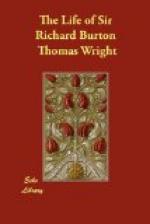187. Burton’s Friends.
Most of Burton’s friends have followed him to the tomb. Edward Rehatsek died at a ripe age at Worli on 11th December 1891, and was cremated in Hindu fashion. At the time of his death he was working at the translation of the third part of The Rauzat-us-Safa.[FN#697] In his last letter to Mr. Arbuthnot, after referring to his declining health, he finished by saying, “Hope, however, never dies; and as work occupies the mind, and keeps off despair, I am determined to translate for you, though slowly, the third part of the Rauzat-us-Safa, so as to make the history of the Khalifahs complete."[FN698]
Mr. Arbuthnot continued to take interest in Oriental matters and wrote prefaces for several translations by Rehatsek and Dr. Steingass, including the First Part of Rehatsek’s Rauzat-us-Safa (1891) and Steingass’s Assemblies of Al Haririr (1898). His Arabic Authors appeared in 1890, his Mysteries of Chronology in 1900. He died in May 1901, and was buried at Shamley Green, Guildford. He left money for the Oriental Translation Fund, of which, it will be remembered, he was the founder, and his memory will always be honoured by Orientalists. A memorial of him—the Arbuthnot Institute—was opened at Shamley Green on 31st May 1905.
Mr. Ashbee died in 1900, Dr. F. J. Steingass in January, 1903.
After Burton’s death, Mr. Letchford went to Bohemia as the guest of the Prince of Thurn and Taxis. At Vienna his next resort, he painted many beautiful pictures, one of the best being founded on Edgar Allen Poe’s poem, “Silence.” Finally he went to Naples, where he produced the series of pictures that has given him immortality—the illustrations to The Arabian Nights. Then followed days of darkness and trouble, but he was always courageous. “He felt that what he had striven for so long was now within his reach; he had the presentiment that he was about to take those flights of art which are permitted to very few.” His portrait of the son of Sir William Wollcock is a work of genius.
In July 1905, hearing that Mr. Letchford was ill, I wrote to his sister, Daisy,[FN#699] who lived with him. The letter was received, and Mr. Letchford intended replying to it himself. “He was only waiting to feel a little stronger,” wrote Miss Letchford, “he never thought the end was near. On Monday morning of the 24th of July he still kept making wonderful plans for the future. He had the room in which he spent his last hours crowded with flowers, and as he felt his powers failing him he recited Swinburne’s beautiful poem, ‘The Garden of Proserpine’:
“Though one were fair as roses
His beauty clouds and closes.”
“Suddenly he lost consciousness, and he awoke from his comatose state only to repeat the identical words which were Sir Richard Burton’s last—’I am dying—I am dead.’ His beautiful soul had left this world for ever, for it was indeed a beautiful soul."[FN#700]




